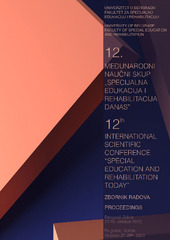Prikaz osnovnih podataka o dokumentu
Verbalna i neverbalna radna memorija kod dece sa razvojnim Jezičkim poremećajem ekspresivnog tipa – preliminarno Istraživanje
Verbal and nonverbal working memory in children with Expressive type of developmental language disorder – a Preliminary research
| dc.creator | Drljan, Bojana | |
| dc.creator | Buha, Nataša | |
| dc.creator | Ječmenica, Nevena | |
| dc.date.accessioned | 2024-01-09T11:03:26Z | |
| dc.date.available | 2024-01-09T11:03:26Z | |
| dc.date.issued | 2023 | |
| dc.identifier.isbn | 978-86-6203-174-7 | |
| dc.identifier.uri | http://rfasper.fasper.bg.ac.rs/handle/123456789/5336 | |
| dc.description.abstract | Uvod: Radna memorija predstavlja kognitivni proces koji se odnosi na održavanje i manipulaciju ograničenog broja informacija tokom kratkog vremenskog perioda, a koji je ključan za funkcionisanje u različitim sferama života jer ima značajnu ulogu u procesiranju jezika. Rezultati prethodnih studija ukazuju na to da deca sa razvojnim jezičkim poremećajem (RJP) imaju manji kapacitet verbalne radne memorije od dece tipičnog jezičkog razvoja istog hronološkog uzrasta, dok nalazi u domenu neverbalne radne memorije nisu tako jednoznačni. Cilj: Ovo istraživanje ima za cilj da utvrdi nivo razvoja verbalne i neverbalne radne memorije kod dece sa RJP ekspresivnog tipa. Metode: Uzorkom je obuhvaćeno 18 ispitanika sa RJP ekspresivnog tipa, uzrasta od pet do devet godina (AS = 6,44; SD = 1,20), većinom muškog pola (83,3%). Za procenu verbalne radne memorije upotrebljen je zadatak Raspon brojeva unazad, a za procenu neverbalne radne memorije zadatak Izbaci uljeza. Rezultati: Analizom postignuća ispitanika utvrđeno je da je kapacitet verbalne radne memorije značajno veći od kapaciteta neverbalne radne memorije (p = 0,008; Cohen’s d = 0,71). Većina ove dece može sa sigurnošću da zadrži i istovremeno obrađuje dve informacije verbalnog tipa, odnosno jednu informaciju vizuospacijalnog karaktera. Zaključak: Rezultati istraživanja pokazuju da deca sa DLD, pored dobro dokumentovanih deficita verbalne radne memorije, mogu imati teškoće i sa vizuospacijalnim aspektom ove sposobnosti. Pored toga neka deca sa DLD mogu ispoljavati više teškoća na planu neverbalne, u poređenju sa verbalnom radnom memorijom. S obzirom na to da je odnos vizuospacijalnih i jezičkih sposobnosti nedovoljno istražen, buduća istraživanja trebalo bi usmeriti ka proučavanju povezanosti neverbalnog aspekta radne memorije i strukturnih aspekata jezika, a radi boljeg uvida kognitivnih mehanizama u osnovi jezičkog profila koji karakteriše DLD. | sr |
| dc.description.abstract | Introduction: Working memory is a cognitive process that involves maintaining and manipulating a limited amount of information over a short period of time, and is crucial for functioning in various spheres of life because it plays a significant role in language processing. Previous studies have shown that children with developmental language disorder (DLD) have a smaller verbal working memory capacity than typically developing peers, while findings in the domain of nonverbal working memory are not as clear. Aim: This study aims to determine the developmental level of verbal and nonverbal working memory in children with expressive-type DLD. Methods: The sample included 18 participants with expressive-type DLD, aged 5-9 years (M = 6.44; SD = 1.20), mostly male (83.3%). The Backward Digit Span task was used to assess verbal working memory, and the Odd- One-Out task was used to assess nonverbal working memory. Results: Analysis of participants’ performance revealed that verbal working memory capacity was significantly higher than nonverbal working memory capacity (p = 0.008; Cohen’s d = 0.71). Most of these children can confidently retain and process two pieces of verbal type information or one piece of visuospatial information simultaneously. Conclusion: The results of the study show that children with DLD, in addition to well-documented deficits in verbal working memory, may also have difficulties with the visuospatial aspect of this ability. In addition, some children with DLD may experience more difficulties with nonverbal compared to verbal working memory. Given that the relationship between visuospatial and language abilities is underexplored, future research should focus on studying the association between the nonverbal aspect of working memory and the structural aspects of language, in order to gain better insight into the cognitive mechanisms underlying the language profile that characterizes DLD. | sr |
| dc.language.iso | sr | sr |
| dc.publisher | Univerzitet u Beogradu – Fakultet za specijalnu edukaciju i rehabilitaciju/ University of Belgrade – Faculty of Special Education and Rehabilitation | sr |
| dc.rights | openAccess | sr |
| dc.rights.uri | https://creativecommons.org/licenses/by-sa/4.0/ | |
| dc.source | Zbornik radova - 12. Međunarodni naučni skup Specijalna edukacija i rehabilitacija danas Beograd, 27–28. oktobar 2023. Godine | sr |
| dc.subject | razvojni jezički poremećaj | sr |
| dc.subject | verbalna radna memorija | sr |
| dc.subject | neverbalna radna memorija | sr |
| dc.subject | vizuospacijalne sposobnosti | sr |
| dc.subject | developmental language disorder | sr |
| dc.subject | verbal working memory | sr |
| dc.subject | nonverbal working memory | sr |
| dc.subject | visuospatial abilities | sr |
| dc.title | Verbalna i neverbalna radna memorija kod dece sa razvojnim Jezičkim poremećajem ekspresivnog tipa – preliminarno Istraživanje | sr |
| dc.title | Verbal and nonverbal working memory in children with Expressive type of developmental language disorder – a Preliminary research | sr |
| dc.type | conferenceObject | sr |
| dc.rights.license | BY-SA | sr |
| dc.citation.epage | 253 | |
| dc.citation.spage | 245 | |
| dc.identifier.fulltext | http://rfasper.fasper.bg.ac.rs/bitstream/id/10917/Untitled2.pdf | |
| dc.identifier.rcub | https://hdl.handle.net/21.15107/rcub_rfasper_5336 | |
| dc.type.version | publishedVersion | sr |


